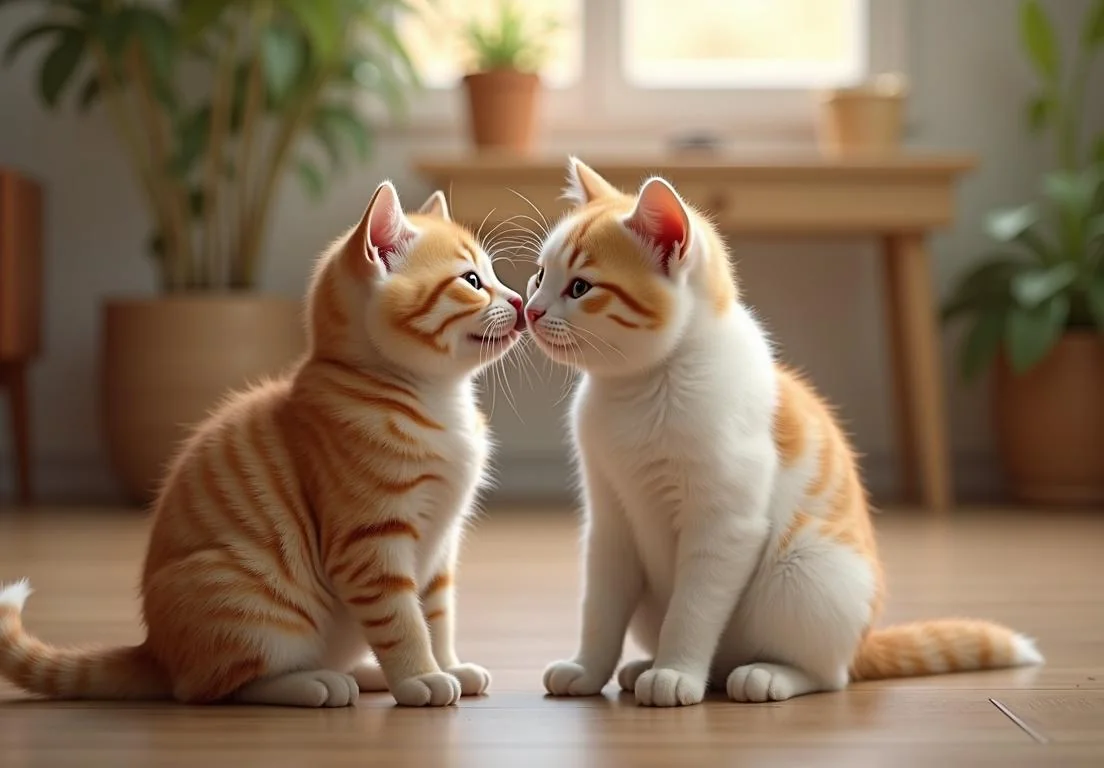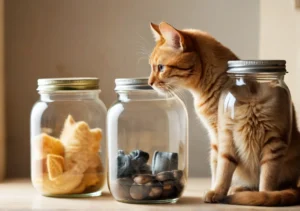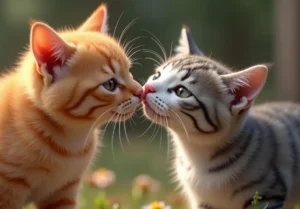Cats have strange ways of showing affection, and one of the most notorious habits is their penchant for sniffing each other’s butts. It’s a puzzling behavior that raises eyebrows among viewers but is perfectly normal among our feline friends.
Cats sniff each other’s butts because it’s a vital means of communication. They gather important social and health information through scent, which helps them identify each other, understand their territory, and even detect pheromones that indicate reproductive status. There’s a lot more to this fascinating ritual than meets the eye, so keep reading to uncover the secrets behind this quirky behavior.

What is the purpose of butt sniffing in cats?
The act of butt sniffing in cats isn’t just a quirky behavior; it serves essential social and communicative functions. Cats have scent glands located around their rear ends, and these glands release various pheromones that provide critical information about an individual’s identity, health, and even reproductive status. So when one kitty gets up close and personal with another’s backside, they’re essentially conducting a thorough background check.
This behavior helps cats establish their place within the social hierarchy. A quick sniff can indicate whether a newcomer poses a threat or is a potential friend. It’s a way to say, “I know you now” without any aggressive display. For cats who may be a bit more reserved, sniffing can ease them into social situations without the stress of direct confrontation.
Additionally, butt sniffing is a way for cats to gather updates. Just like catching up with a friend, a good whiff can tell them who’s been hanging around, what’s going on in the neighborhood, and even what other cats have been eating or feeling. In essence, this behavior is part of their social toolkit that keeps relationships within their community healthy and informed.
Scent is the backbone of a cat’s communication. Unlike humans, who rely heavily on verbal language, cats are much more in tune with their sense of smell. It’s how they express themselves and understand their environment. Have you noticed your cat trailing behind another in a sniffing frenzy? That’s because they’re gathering information that goes beyond just identifying who’s who in the neighborhood.
In the feline world, scent can indicate health, territory, and even emotions. Cats have special vomeronasal organs, located on the roof of their mouths, that help them process pheromones. When they engage in sniffing, they’re not just catching a whiff; they’re absorbing important chemical signals that inform them about other cats’ feelings and reproductive readiness.
Here are a few key aspects of how scent influences cat interactions:
Territory Marking : A cat will often use its scent to mark regions as its own. This behavior can involve both urine marking and the scent they leave from rubbing against objects.
Mating Signals : A female cat in heat will emit specific scents that signal her readiness to mate, triggering responses from the males nearby.
Social Bonds : Scent helps strengthen social ties. When cats groom each other, they’re not just keeping clean; they’re also exchanging scents that enhance social bonds.
Understanding the significance of scent in their social lives enriches our appreciation for our furry companions. The next time you witness that curious butt sniff, remember: it’s a world of communication happening right before your eyes.
What can butt sniffing reveal about a cat’s health?
Butt sniffing isn’t just some quirky cat behavior; it can actually serve as a health check in feline social interactions. Cats have a remarkably keen sense of smell, with up to 80 million olfactory receptors, allowing them to pick up on various scents, including pheromones that can hint at a cat’s health status.
When one cat sniffs another’s rear, they’re likely gathering information about hormonal changes, diet, and even potential health issues. For instance, a sudden change in scent could signal an underlying health problem, like an infection or gastrointestinal issues.
Furthermore, pheromones released from the anal glands can indicate a cat’s reproductive status, which is crucial for both mating behavior and understanding social hierarchies within a group. If a cat is sniffing another frequently or with great interest, it might indicate a need for social bonding or territory assessment, rather than just simple curiosity.
By reading these olfactory cues, cats maintain their social structures and can also avoid potentially harmful interactions with sick or unfit members of their community. Understanding this helps us appreciate how essential scent is in the feline world.
Are there different meanings behind this behavior?
Butt sniffing can mean a lot more than just a casual greeting; it’s a complex form of communication rich in context. Greeting is a primary reason—when two cats meet, a quick sniff often serves as an introduction, helping them gather background information about one another.
Curiosity also plays a big role. Cats are naturally inquisitive creatures, and a strong whiff of something unusual can pique their interest, leading to a nose-to-rear inspection. It’s all about getting the scoop on their surroundings.
Then there’s the idea of dominance. In hierarchical settings, butt sniffing can be a way for more dominant cats to assert their status. The act is more than ritualistic; it can establish or reinforce the pecking order, signaling who’s in charge in a subtle yet effective way.
In essence, interpreting butt sniffing involves considering not just the act itself, but also the context—what’s happening in the environment, the cats’ prior experiences, and their social dynamics. Being aware of these nuances can truly enrich our understanding of feline behavior.
How do kittens learn this behavior?
Kittens pick up the habit of sniffing each other’s butts from a young age, and it’s a vital part of their social development. This behavior is rooted in instinct and serves several key purposes. Initially, mothers play a crucial role by stimulating their kittens’ backsides to encourage elimination, which helps keep the den clean. Soon, the kittens start exploring their world, and sniffing becomes a way to gather information about their peers.
Through play and interactions, they learn that this behavior is a way to greet and understand one another. By smelling another cat’s rear end, they can gather details about age, sex, health, and even mood. It’s essentially a feline handshake. This behavior is reinforced through positive encounters, which helps them establish bonds with littermates and future companions. Over time, it becomes a natural way to communicate and exchange important social cues in their environment.
What do experts say about this behavior?
Veterinarians and animal behaviorists often emphasize that this butt-sniffing ritual is a normal, healthy part of cat behavior. According to experts, it’s rooted in a cat’s highly developed sense of smell, which is roughly 14 times stronger than that of humans. They suggest that when cats sniff each other’s behinds, they’re engaging in a form of social interaction, akin to our introductions or checking in on friends.
Dr. John Bradshaw, a feline behaviorist, indicates that this form of greeting serves a crucial role in establishing hierarchy and territory among cats. Additionally, it helps them identify new cats in the area, ensuring they’re aware of potential threats or newcomers.
Interestingly, some experts liken this sniffing to how we might shake hands or hug—though, let’s face it, their method is a bit more straight to the point. In any case, it’s clear that while it may seem odd to us, this behavior is a key part of how cats communicate and build social connections in the feline world.
Is butt sniffing safe for cats?
Butt sniffing is a natural social behavior among cats that’s typically harmless. It’s how they gather important information about one another—like age, health, and sexual status—via scent glands located around their rear end. However, there are some safety considerations to keep in mind.
Health Risks: While outright dangerous incidents are rare, potential issues do exist. If one cat is carrying bacteria or parasites, it can easily transfer them during such encounters. To mitigate these risks, it’s essential to ensure your cats are up to date on their vaccinations and regular health check-ups.
Hygiene Tips:
– Regular Grooming: Keep your cats clean and well-groomed. This reduces the chances of infections and helps maintain a healthy environment in shared spaces.
– Watch for Symptoms: Keep an eye out for any signs of illness or discomfort in your cats. If one of them seems to have an upset stomach or unusual behavior after sniffing, a quick vet visit is a smart move.
– Separation When Necessary: If introducing a new cat, consider initial separation until you’re sure they’re healthy. Let them sniff each other’s scent on toys or bedding first.
Being proactive about health and hygiene can keep your feline friends safe while they engage in their quirky, yet natural behavior.
Funny cat stories: butt sniffing in popular culture
Butt sniffing might seem a bit crude, but it hilariously pops up everywhere in pop culture, providing a light-hearted glimpse into feline behavior. From cartoon antics to social media memes, here’s how it’s portrayed and received.
In the hit animated film “The Secret Life of Pets,” there’s a memorable scene where the dogs’ reactions to this cat behavior add a layer of humor, showcasing the different perspectives animals have towards each other. The visual comedy of pets navigating each other’s social norms makes it relatable for viewers.
On social media platforms, you’ll find countless memes of cats caught in awkward butt-sniffing situations, often paired with witty captions—”When you gotta know if it’s cool to sit here.” This culture helps remind cat owners that their pets have these unique interactions, often making us see our cats’ natural behaviors as endearing quirks rather than oddities.
These light-hearted portrayals serve not only to entertain but also to normalize the behavior, reminding us that butt sniffing is just another way cats communicate. It fosters a shared chuckle among cat lovers, reinforcing that even in their oddest moments, our feline friends can bring joy and laughter into our lives.
Recent studies on feline communication
Cats have a fascinating way of connecting, and recent studies reveal that scent communication is at the heart of their social interactions. Contrary to what some might think, those butt sniffs aren’t just random acts—they’re a crucial part of how felines gather detailed information about each other.
For one, research shows that cats have specialized glands located around their rear ends that release pheromones. These chemical signals provide insights into a cat’s health, emotional state, and even identity. When they sniff each other, they’re almost like detectives piecing together a profile of their furry acquaintances.
A study published in the journal Applied Animal Behaviour Science noted that this behavior isn’t limited to just greeting one another; it plays a significant role in establishing social bonds and hierarchy within a group. Younger cats, especially, can learn about potential mates, rivals, and pals simply through these sniff exchanges.
Interestingly, the act is more frequent among cats that know each other well. It suggests that familiarity influences how open they are to sniffing each other’s rear ends. This behavior serves a dual purpose: it’s both an introduction and a way to reaffirm connections among related or friendly cats.
So, the next time you catch your kitty getting a little too nosey, remember—it’s not just about curiosity; it’s a multifaceted communication strategy that helps them navigate their social world. These insights from recent studies pave the way for understanding feline relationships on a deeper level.
Alex, a passionate animal lover, has experience in training and understanding animal behavior. As a proud pet parent to two dogs and three cats, he founded AnimalReport.net to share insights from animal experts and expand his knowledge of the animal kingdom.




